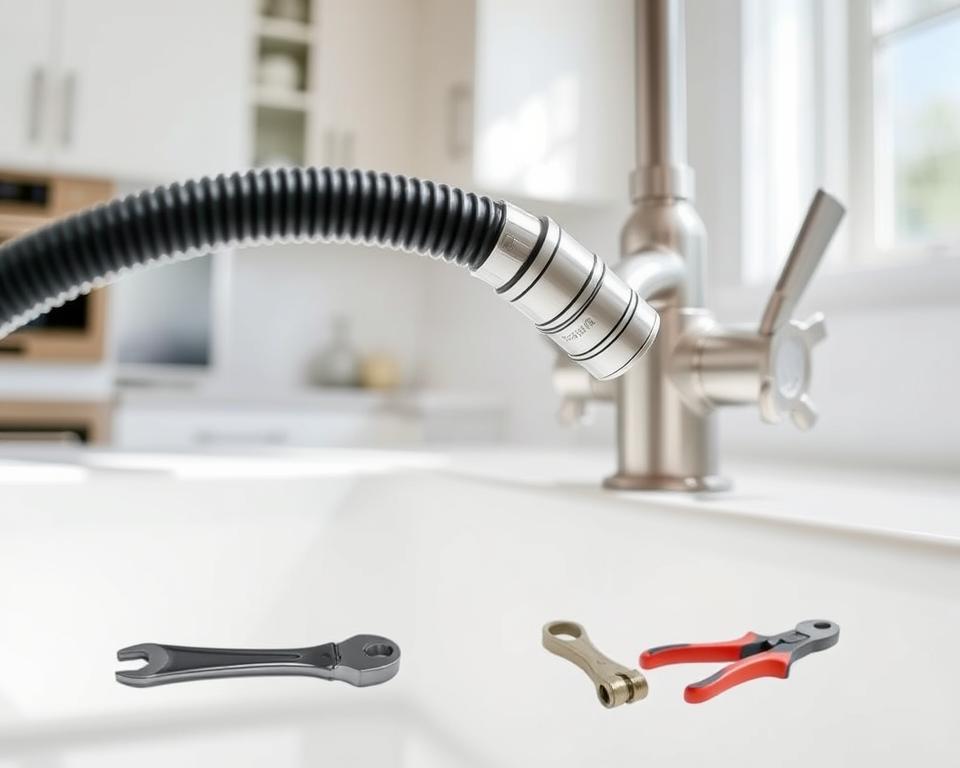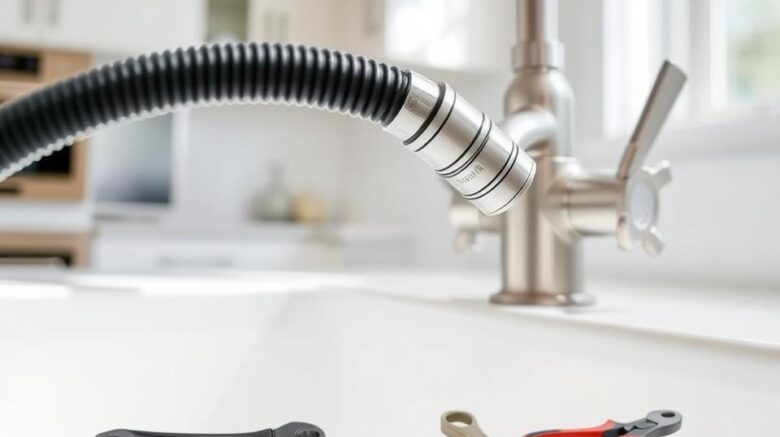Ultimate Guide to Kitchen Sink Hose Connections
Were you aware attaching a kitchen sink hose attachment could cut down on your utility costs? While the specific economies fluctuate, the inclusion is meaningful. A premier kitchen sink hose attachment enhances both function and water conservation, enhancing any kitchen. This comprehensive handbook delves into their value, merits, and the way they innovate everyday kitchen tasks, like produce cleaning and plate washing.
Versions from 2016 and 2017 vary in endurance and utility. Regardless of their manufacturing period, installation correctness is crucial; this often involves removal of strainers or screens, necessary in all cases. Routine servicing is also critical to keep sink water line adapter in optimal shape.
At Installation Parts Supply, we provide a diverse selection designed for different sinks, prioritizing durability and functionality. In the following, we examine the varieties, perks, and upkeep for kitchen sink hose attachments.
Important Lessons
- Attaching a kitchen sink hose attachment may decrease water costs.
- Accurate installation ensures optimal operation; detaching strainers is a vital measure.
- Maintain your hose attachment by routine cleaning.
- The type of material affects resilience; PVC is prevalent but might bend improperly.
- Leak inspection post-installation is imperative for proper operation.
- Using premium clamps improves durability and pressure resistance.
- Discover varieties at Installation Parts Supply for multiple kitchen demands.
Introduction to kitchen sink hose Connections
A kitchen sink hose attachment connects to your faucet for easy water flow management. They are offered in types like brass and quick connect. This setup improves mobility, enabling users to reach difficult areas easily. An cost-effective attachment can enhance kitchen performance and streamline duties.
Understanding a kitchen sink hose Device?
This attachment incorporates a pliant hose that directs water flow precisely to the required area. Manufactured from materials like brass and polymer, delivering durability choices. Featuring both pull-out and pull-down styles, they work well for a range of functions. Such functions include dish rinsing and produce rinsing.
Advantages of Employing a kitchen sink hose Device
Kitchen sink hose attachments deliver various merits. They enable adaptable water flow control, optimizing water dispersion and direction. This adaptability facilitates maintaining narrow areas or large objects. They are also easy to install, without professional intervention. With different price points, locating a budget-friendly model is effortless, thereby improving your kitchen setup.
Varieties of kitchen sink hose Add-ons
Finding the appropriate kitchen sink hose attachment is crucial for addressing your demands. Every model has unique roles, featuring distinctive advantages. Familiarizing yourself with both pliant and stiff selections, alongside garden hose adapters, improves your kitchen’s utility.

Pliable kitchen sink hose Devices
Flexible kitchen sink hose attachments deliver incomparable adaptability. Ideal for navigating tricky spots around the sink, they make dish rinsing or washing fruits and vegetables a breeze. Their ability to twist and turn into narrow spaces is highly valued. The popularity of these attachments is on the rise due to their functionality and ease of use.
Firm kitchen sink hose Attachments
Rigid kitchen sink hose attachments are recognized for their rigidity, ensuring consistent water flow. They are essential for pot filling or rinsing bulky objects with simplicity. Built using durable materials like stainless steel, they are highly resistant to damage. Users favor these for their anti-leak properties, affirming their reliability for everyday use.
Couplings for Garden Hoses
Adapters for garden hoses connect kitchen faucets with outdoor hoses seamlessly. They’re a boon for outdoor chores, from watering the garden to washing outdoor furniture. These adapters minimize manual work, preventing the need to move water-filled buckets. Since most faucets are compatible with garden hoses, they provide wide adaptability and user-friendliness.
How to Choose the Best kitchen sink hose Accessory
Selecting the appropriate kitchen sink hose attachment involves considering several factors. These aspects boost both performance and convenience in your kitchen space. It is essential to find products that offer longevity and are constructed of quality materials. Simple installation and the fitting of the attachment with your sink play a pivotal role in making the best choice.
Longevity and Build Quality
In your pursuit for a long-lasting kitchen sink hose attachment, focus on the construction materials. Selections including stainless steel, granite, and top-quality plastics offer longevity. They are known for their durability under stress. Selecting a robust model, you secure years of consistent operation, keeping it in optimal condition despite regular use.
Installation Simplicity
A kitchen sink hose attachment offering effortless setup facilitates the entire process. Many models are built with simplicity in mind, suited for users without extensive DIY expertise. Select an attachment that includes clear instructions and all necessary accessories. This secures a swift and hassle-free installation process.
Fit with Your Sink
Verifying your kitchen sink hose attachment aligns with your sink is crucial. Most sinks feature pre-drilled holes for these accessories. You must opt for an attachment that complements your sink’s style. Accurate matching eradicates issues such as leaks, so that your attachment functions seamlessly.
Easy Installation of kitchen sink hose Attachments
Mounting a kitchen sink hose attachment might look challenging. Nonetheless, a clear series of actions makes easier the process. This uncomplicated method ensures anyone to improve their kitchen’s utility. It outlines a comprehensive procedure for fitting a kitchen sink hose, with the required equipment.
Step-by-Step Fitting Manual
Commence by collecting all required materials and tools. Use an aerator removal tool to detach the faucet’s aerator. Determine if your faucet has male or female threads for proper connection. Wrap Teflon tape around the faucet spout for a secure, leak-free seal if needed.
Next, secure the correct faucet adapter. Ensure its tight fixation to prevent leaks. Place a rubber gasket for a firm bond; this will help avert leaks if properly installed. Apply vinyl grip tape on the wrench to protect surfaces from scratches during use. Take extra caution to not strip the threads, which may damage the faucet.
When a vacuum breaker is absent, incorporating a hose-type vacuum breaker is advisable for system integrity. Make sure to depressurize the hose prior to detachment to avoid water splashing.
Installation Equipment
| Device | Function |
|---|---|
| Tool for Removing Aerators | To unscrew the aerator from the faucet |
| PTFE Tape | Use Teflon tape on the faucet spout for a secure seal |
| Adjustable Tool | Fasten the faucet adapter safely |
| Rubber Sealing Ring | Ensure a tight connection to prevent leaks |
| Non-slip Tape | Protect surfaces while using tools |
Upkeeping Your kitchen sink hose Attachment
To make sure your kitchen sink hose attachment operates efficiently and endures, regular maintenance is key. By adopting suitable cleaning practices and identifying when to replace it, you can avert major issues in the future.
Guidelines for Cleaning and Care
Keeping clean your kitchen sink hose attachment is crucial for its performance. A solution of white vinegar (5-10% acetic acid) is great at removing scale buildup that result in obstructions. Here are effective cleaning guidelines:
- Submerge the sink sprayer cover in vinegar for no less than 1.5 hours to ensure complete cleaning.
- In legacy models, take apart the sprayer and submerge its elements like the perforated disk, covering sleeve, and gaskets.
- In modern versions, merely turn the spray head in the reverse direction to easily reach its inside elements.
- A different approach for modern sprayers is to submerge them in a bag filled with vinegar, making sure the sprayer is entirely submerged, for an identical period of 1.5 hours.
Since hard water minerals are a common cause of clogs in sink sprayers blockages, regular cleaning is essential for optimal performance.
When to Change Your Hose Attachment
Knowing when to replace your kitchen sink hose is essential for avoiding plumbing problems. Look for these signs:
- If leaks occur, it suggests the hose material is failing, signifying replacement is due.
- Noticeable fissures in the hose signal a compromised build.
- Reduced water flow may signal clogs or damage, suggesting a replacement is needed.
Timely upkeep of your kitchen sink hose attachment can significantly increase its durability, ensuring optimal kitchen performance.
As a Final Point
Incorporating a kitchen sink hose attachment can significantly enhance your kitchen’s effectiveness. Our comprehensive guide covered the types, advantages, and maintenance tips of hose attachments. If you aim to upgrade your kitchen chores or revamp your area, a hose attachment offers versatility and performance.
Such devices bring better temperature control and water flow. They simplify tackling food particles easy, maintaining a clean area. Their advantages in everyday kitchen tasks are undeniable, streamlining your maintenance tasks significantly.
Enhancing your kitchen need not be difficult or costly. Offering choices for every budget and style, a kitchen sink hose attachment has the potential to revolutionize your culinary space. Opting for high-quality selections, like those from Installation Parts Supply, you guarantee durability and contentment.
Frequently Asked Questions
Defining a kitchen sink hose attachment?
A kitchen sink hose attachment attaches to your faucet, converting it to a water sprayer. Such a change increases water usage flexibility. It eases activities such as washing and gardening.
What is the process for installing a kitchen sink hose attachment?
To install, start by detaching your faucet’s aerator. Afterwards, connect the right faucet adapter. Make sure all connections are firm and leak-proof. An adjustable wrench and Teflon tape are typically required an adjustable wrench and Teflon tape.
What should I consider when choosing the best kitchen sink hose attachment?
While picking, consider durability, construction standards, installation simplicity, and how well it fits your sink and faucet. Stainless steel or superior plastics offer more durability.
Are kitchen sink hose attachments are easy to maintain?
Indeed, maintenance is straightforward. Clean with vinegar to eliminate mineral buildup. Periodically examine for leaks and clogs. Replace the attachment if it cracks, leaks, or restricts water flow.
May I use a kitchen sink hose attachment for outdoor tasks?
Certainly, by attaching it to garden hoses with adapters, it becomes ideal for outdoor tasks like garden watering.
Do cost-effective kitchen sink hose attachments?
Certainly, the market features numerous cost-effective selections. Installation Parts Supply supplies a selection that combines low cost with high quality.
How do flexible and rigid hose attachments differ
Bendable hose attachments can curve to access obscure angles, boosting versatility for different tasks. Stiff hose attachments retain their rigidity, providing stable water flow direction. They tend to be more durable.
